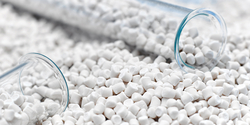Masterbatch is a solid additive that is encapsulated in a carrier resin through a heat process, then cooled and cut into granular shapes. It is a mixture of polymer and calcium carbonate that is widely used in plastic-based product manufacturing. It has a good percentage of calcium carbonate powder (82%) combined with the resin (18%) and appropriate additives.
The addition of calcium carbonate in plastics can improve processing, performance, sustainability, and the finish impact of the final product. The use of calcium carbonate as a filler is 100% FDA approved, making it versatile in applications, including critical ones like food and medical packaging. Filler Masterbatches are cost-effective, save production costs, and enhance multiple properties of the final products.
Masterbatch is used as a filler in the manufacturing of products like Blown HDPE Film, Raffia tapes, Tarpaulins, High-density and Low-density PP/PE fabric, LDPE, LLDPE, and HDPE films, and plastic furniture.
Adding calcium carbonate filler helps improve product surfaces by:
Reducing luster, making the surface more matte and opaquer
Giving natural white color with limited yellowness
Creating more micro areas for air filtration and oil absorption
Increasing thermal conductivity and physical strength
Reducing processing temperature, hence the manufacturers can achieve higher productivity as well as save energy and producing costs in general.
Easily cooperated with multiple base resins (thanks to good dispersion ability) and processed by various methods
Applications
Extrusion: to improve stiffness, strength, and impact resistance
Injection molding: to improve flow properties, reduce shrinkage and warpage
Blow molding: to improve rigidity and strength of plastic bottles and containers
Film production: to improve opacity, whiteness, and smoothness of plastic films
Pipe and profile production: to improve stiffness, impact resistance, and surface finish
Cable production: to improve tensile strength and flame retardancy
Rotational molding: to improve dimensional stability, stiffness, and impact resistance
Thermoforming: to improve surface finish, opacity, and whiteness
Automotive industry: to improve mechanical properties and reduce weight of automotive parts
Packaging industry: to improve stiffness, strength, and barrier properties of plastic packaging materials
Electrical and electronics industry: to improve strength, dimensional stability, and flame retardancy of plastic electrical and electronic components.
Loading Percentages:
In general, the loading percentage of filler masterbatches typically falls within a range of 10% to 40%. Here's a breakdown of loading percentages in filler masterbatches:
Plastic Extrusion (e.g., pipes, profiles, sheets):
Low Loading (10%-20%): In some cases, a low loading of filler masterbatch can be used to reduce material costs without significantly compromising the mechanical properties of the plastic products.
Medium Loading (20%-30%): Many plastic extrusion applications use filler masterbatches in this range to balance cost savings with maintaining essential properties.
High Loading (30%-40% and above): Some non-critical applications, such as utility pipes, may use high loading percentages to achieve substantial cost reductions.
Blow Moulding (e.g., bottles, containers):
Low to Medium Loading (10%-30%): Blow-molded products often use filler masterbatches to improve stiffness, reduce weight, and lower production costs while maintaining product quality.
Injection Moulding (e.g., automotive parts, consumer goods):
Low to Medium Loading (10%-30%): Injection-molded parts can benefit from filler masterbatches in this range to enhance dimensional stability and reduce manufacturing costs.
Film and Packaging (e.g., bags, packaging films):
Low Loading (10%-20%): Filler masterbatches are used to reduce film thickness, improve barrier properties, and decrease material costs.
Medium Loading (20%-30%): Some films may use higher loading percentages to achieve specific properties like opacity and rigidity.
Wire and Cable Insulation:
Medium Loading (20%-30%): Filler masterbatches are added to cable insulation compounds to improve electrical properties and reduce production costs.
Rubber Compounding (e.g., tires, conveyor belts):
Medium Loading (20%-30%): Rubber formulations often incorporate filler masterbatches to improve wear resistance, reduce rolling resistance, and enhance cost-effectiveness.
Construction Materials (e.g., PVC pipes, roofing membranes):
Medium to High Loading (20%-40% and above): Building materials may use higher loading percentages of filler masterbatches to meet specific structural and cost requirements.
Automotive Parts (e.g., interior components, under-the-hood parts):
Medium Loading (20%-30%): Automotive applications often utilize filler masterbatches to reduce weight and improve dimensional stability.
Thermoplastic Compounds (e.g., masterbatches for colouring, UV protection):
Loading percentages can vary widely depending on the desired colour or additive effects. It can range from low to medium loading, depending on the application.
- Product Details
- Brand :
- Place of Origin : Not Given
- FOB Price : On Request
- Minimum Order Quantity : Not Given
- Supply Ability :
- Packaging & Delivery
- Packaging Detail : Not Given
- Delivery Detail : Not Given




